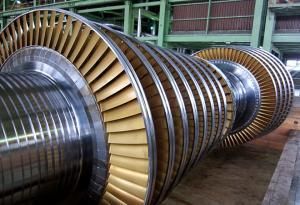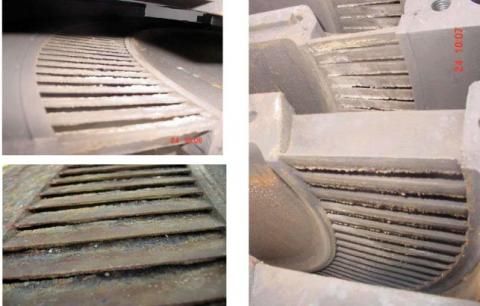Choosing online and offline cleaning of steam turbines

Below are excerpts from a case study presented by Bladimir Gomez, supervisor for rotating equipment engineering at PDVSA CRP Refinery and Barry Snider, president of Small Hammer Incorporated at the 2013 Turbomachinery Symposium at Houston.
Problems encountered at the PDVSA plant
Steam turbines losing power and speed
• Several occurrences isolated to multistage turbines driving critical compressors
• Governor/steam valve unable to maintain desired rpm
• Unit production reduced
• Lost revenue
Fouling of turbine rotor blades and static guide vanes was observed. The fouling zone was just ahead of the saturation zone in the steam turbine. Fouling consists of water soluble chemicals [NaCl, NaOH] bound with Insoluble Oxides [Fe, Si, Al] greater than 50 ppb
Cleaning methods considered
1. Offline mechanical cleaning with aluminum oxide offers guaranteed results, allows for inspection of rotor and other components, requires disassembly, extended downtime, utilizes multiple resources and is intrusive.
2. Offline slow-roll soak and flush with hot water requires no disassembly, has short downtime, low risk, requires no modification of facilities, and results are not guaranteed.
Online cleaning would require adjusting the steam pressure and temperature so that the saturation zone moves to the fouling zone, and the salts are washed away. Online Manipulation of Saturation Point would mean no disassembly, no downtime but some lost production, medium risk managing axial thrust, no modification of facilities and results not guaranteed.
Online Water Injection into Steam at turbine inlet would mean no disassembly, medium risk managing axial thrust, no downtime for cleaning but requires modifications of facilities (downtime) and results not guaranteed.

(Fouling in steam turbines)
For Turbine #1, a 3-Stage turbine, no extraction machine with no turning gear, the selected cleaning method was offline mechanical cleaning with disassembly was chosen
For Turbine #2, a 10-Stage turbine with extraction and turning gear, offline slow roll soak with hot water (no disassembly) was selected.
Slow-roll soak cleaning procedure
1. Develop plan for measuring conductivity (hardness) of water exiting turbine
2. Shut down turbine/compressor and place on slow roll using turning gear
3. Close all valves except for sentinel valve and leaving free flow open to/from condenser
4. Slowly fill turbine to 100 percent by flooding condenser with hot water/condensate allowing overflow from the sentinel valve
5. Allow turbine to slow roll with water flowing for several hours while monitoring conductivity (hardness). When conductivity becomes equal to water flowing in, cleaning is complete.
After the cleaning processes, the rpm, steam flow and steam valve opening were restored to normal.